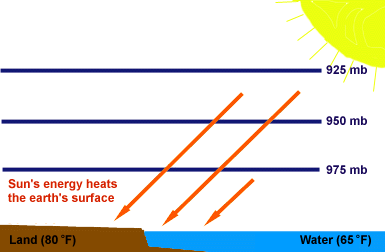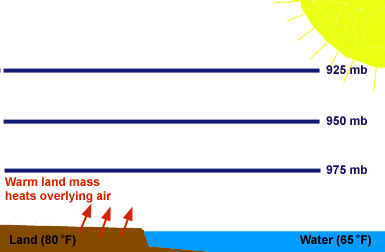When spending a day at the beach, a noticeable drop in temperature may occur during the early afternoon as a cool breeze begins to blow off of the water. This wind is known as the "sea breeze", which occurs in response to differences in temperature between a body of water and neighboring land.

Sea-breeze circulations most often occur on warm sunny days during the spring and summer when the temperature of the land is normally higher than the temperature of the water. During the early morning hours, the land and the water start out at roughly the same temperature. On a calm morning, a given pressure surface will be at the same height above both the land and water.

A few hours later, the sun's energy begins to warm the land more rapidly than the water. By later in the day, the temperature of the land increases while the temperature of the water remains relatively constant. This occurs because water, especially large bodies of water like a lake or ocean, are able to absorb more energy than land without warming.
It is important to remember that the air is not heated directly from above by the sun. In fact, most of the incoming solar energy actually passes right through the atmosphere. However, as the land absorbs this energy, heat is radiated back into the atmosphere (from the earth), warming the overlying air. Some of this heat is transported to higher levels in the atmosphere through convection.

On the other hand, since the temperature of the water remains relatively constant throughout the day, the air over the water is not heated from below (as over land), resulting in lower air temperatures over the water.

Forces, Winds |
|

offshore flow aloft |